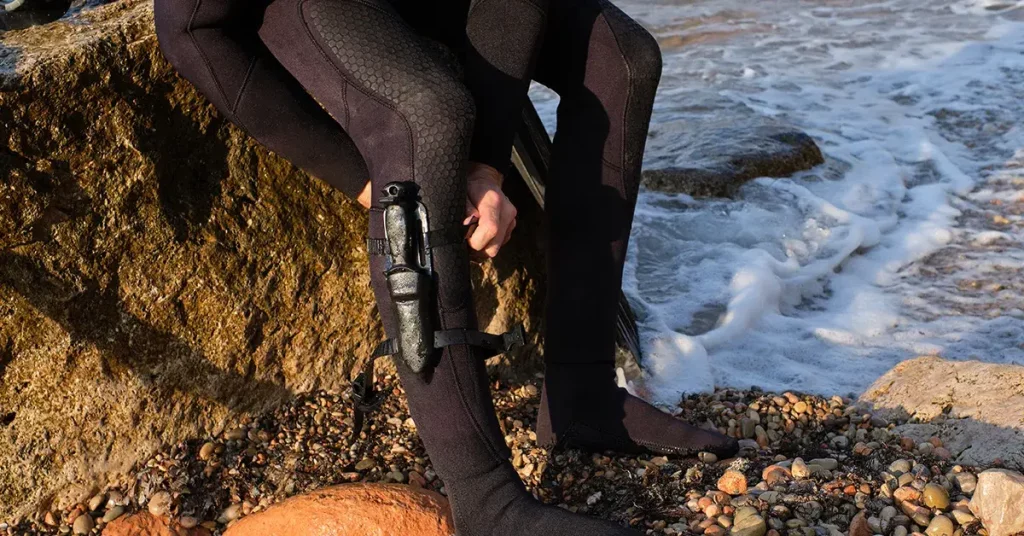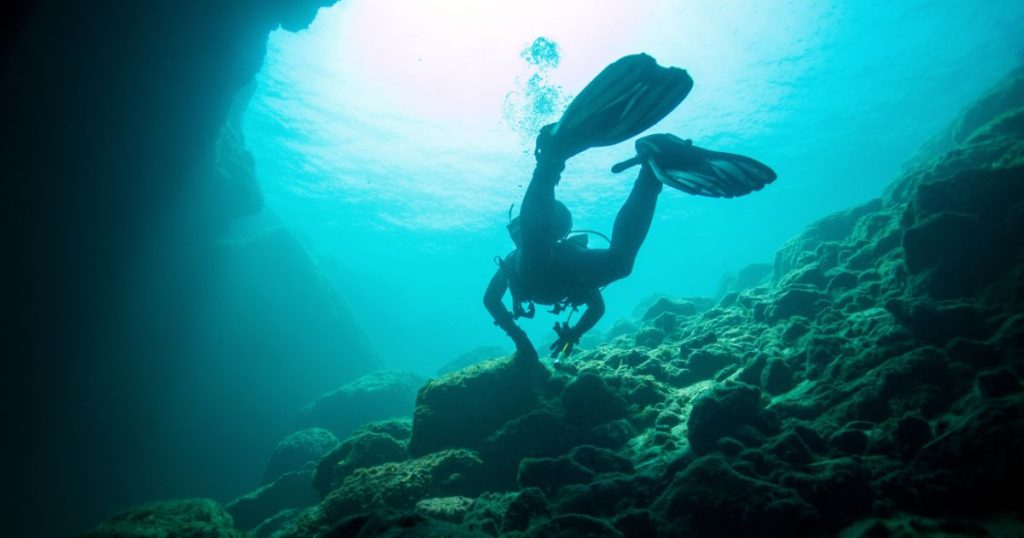A good dive knife does more than look cool strapped to your leg – it could even save your life one day! Becoming entangled in discarded fishing nets or kelp can happen to anyone, so having a sharp dive knife within arm’s reach is a must.
A dive knife might not be the first thing beginner divers think of when considering diving gear, but it really should be. It’s a key piece of emergency equipment.
If you’re a recreational diver, it’s not something you’re likely to use often, but when you do use it you’ll be happy you brought it.
While you might not need a dive knife if you’re just going on a guided tour, it certainly can’t hurt. If you dive in wrecks, caves, or murky water – you absolutely need a dive knife handy at all times. Similarly, if you spearfish, you’ll need a knife to quickly and humanely dispatch your catch.
Quick Answer: 6 Best Dive Knives
- Best Overall: Promate Scuba Dive Titanium Knife
- Best Dive Knife for Spearfishing: Riffe Standard Spearfisher’s Knife
- Best Compact Dive Knife: Cressi Lima Dive Knife
- Best Titanium Dive Knife: Promate Barracuda
- Best Diving Knife for the Money: Cressi Borg
- Best Folding Dive Knife: Spyderco Salt 2
Why do you need a dive knife
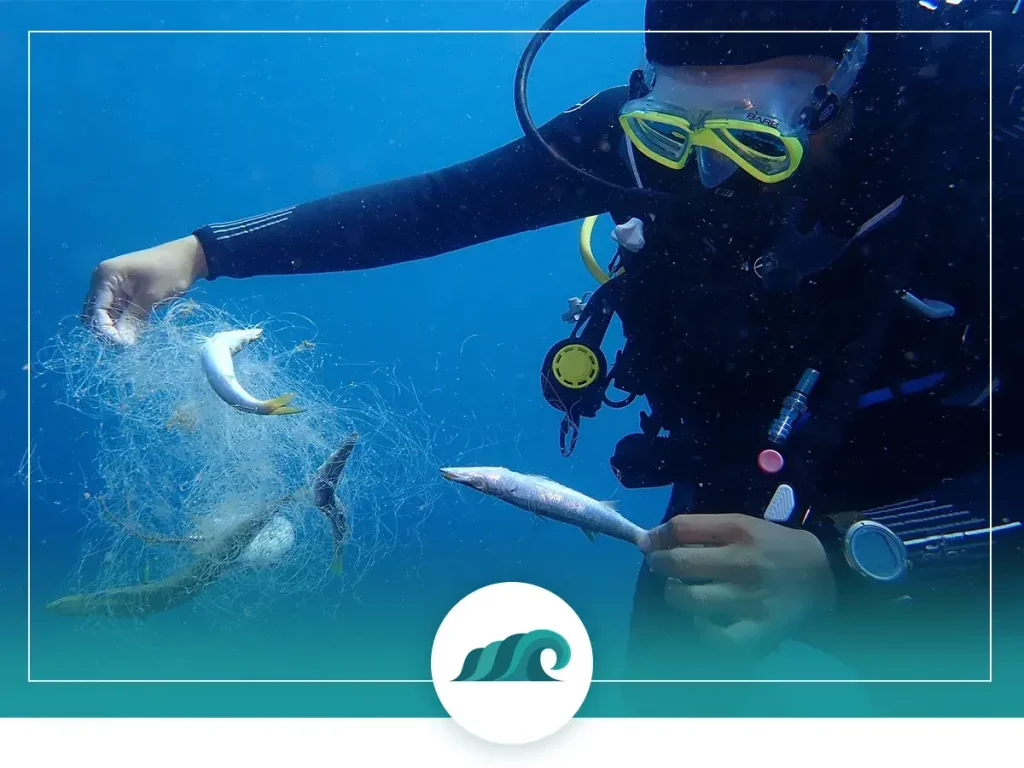
So why do you need a specialized dive knife anyway? Can’t you use any old pocket knife?
The main reason you need a specialized dive knife is because of saltwater corrosion. Regular carbon steel blades will quickly corrode and deteriorate if exposed to saltwater for prolonged periods of time.
Dive knives are made of corrosion-resistant materials like titanium and stainless steel – which means they can withstand the saltwater environment.
A dive knife can save your life in emergency situations.
While not a common occurrence, discarded fishing nets or lines can cause you or your dive buddy to become entangled and lead to a dangerous situation. Kelp and seaweed can present similar dangers. A sharp dive knife can make quick work of these hazards.
Unfortunately, with more plastic and garbage in our oceans than ever before, encountering marine life trapped in plastic, netting, or six-pack rings is increasingly common. Keeping a dive knife with you means you’ll be able to free a trapped fish or turtle – which I’m sure they’ll be thankful for!
If you spearfish, then a good dive knife is an absolute must. A kill knife lets you promptly finish off a thrashing fish with a quick stab to the brain stem. This means less attention from potential predators and a quick end for the fish.
As large predators like sharks and marlin are naturally attracted to trashing and bleeding fish, you’re dive knife also doubles as a form of self-defense from these potential hazards. Lastly, if you’re spearfishing you can become entangled in your own dive float line – which you could cut with a dive knife if necessary.
More dive knife benefits:
- Can be used as a prybar for prying, digging or hacking
- Most knives have dark coating – which attracts less attention from predators
- Key piece of dive safety gear – will give you peace of mind
Best Overall: Promate Scuba Dive Titanium Knife
This versatile and lightweight full-sized blade is ideal for any type of diving. It strikes a good balance between price, quality, and size. The titanium blade measures 4.5”, while the overall length is 9.5”.
Because of the all-titanium blade construction, this blade doesn’t require you to baby it as some stainless steel blades do. All the maintenance it requires is a quick freshwater rinse after each use.
The full tang construction makes it durable and solid-feeling, while the titanium hammer on the pommel is great for hammering or tapping to communicate. The rubber grip is solid feeling with raised bumps that secure the blade in your palm.
A durable ABS plastic sheath with 2 rubber leg straps is included – which utilizes a double push-button release lock to keep the blade in place. The blade is available in both sharp tip and blunt tip configurations, as well as a variety of handle colors.
Key Features
- Full tang titanium construction needs little to no maintenance
- Lightweight and corrosion resistant
- The rubber handle grip is secure and ergonomic
Best Dive Knife for Spearfishing: Riffe Standard Spearfisher’s Knife
This well-made knife from spearfishing experts Riffe is the ideal blade for quickly and safely dispatching any sized fish after spearing. The double-edged stiletto blade features both a serrated and straight edge – which makes it great at cutting through stainless steel cable, monofilament line, and nylon rope. The blade comes coated with dark Teflon, which helps protect it from UV and saltwater.
Measuring 4.5” long, the blade is large enough to deal with larger pelagic fish or makes a solid general-use dive knife. Like all stainless steel blades, the 420 hardened stainless steel blade needs to be rinsed in freshwater and dried after use.
The rubber grip is ergonomic and gives you a solid purchase on the knife. The knife comes bundled with a useable but not perfect sheath and two rubber leg straps.
Key Features
- Blade length 4.5” – Overall Length 8.5”
- Dark Teflon coating offers UV and saltwater protection
- The stiletto shape will pierce through rib or bone without getting stuck
Best Compact Dive Knife: Cressi Lima Dive Knife
With a blade length of just 2.95” and an overall length of 6.3”, this little blade works perfectly as a BCD knife, or for anyone who wants a compact emergency cutting tool. The blade is double-sided, with a serrated edge for sawing through rope and a straight edge for typical cutting tasks. There’s also a special ‘line cutter’ notch for cutting through monofilament line.
The blade is made from 304 stainless steel – which makes it more corrosion resistant than typical stainless steel alloys – but it won’t retain an edge as well. There’s also a titanium version available for a few bucks more.
The sheath is well designed, with a push-button locking mechanism that’s easy to operate one-handed. Overall, the Lima works perfectly for an occasional recreational diver, or as a backup blade.
Key Features
- Compact emergency blade small enough to mount on waist or BCD
- Works well as a backup blade
- The price is right – at less than $20, it’s a steal
Best Titanium Dive Knife: Promate Barracuda
This lightweight, all-titanium dive knife will not only help you out in emergency situations – it looks pretty slick too! The blade measures a beefy 5”, while the overall knife length is 10.5”.
Both a serrated and straight edge is included, as well as a line cutter notch for slicing through fishing line. The blade comes razor sharp from the factory – so be careful not to cut yourself!
Like all titanium blades, it requires minimal maintenance and won’t corrode from saltwater exposure. It can also be fully disassembled for cleaning. The full tang construction and heavy end cap give the knife an extremely solid feel in hand.
A well designed hard plastic sheath is included, which allows for one-handed deployment and re-sheathing. Two adjustable rubber leg straps allow you to mount the blade anywhere on your leg.
Key Features
- Corrosion proof titanium blade requires little to no maintenance.
- Molded finger-grooved rubber grip gives excellent hand feel.
- Weight much less than similar sized stainless steel dive knives.
Best Diving Knife for the Money: Cressi Borg
Cressi really built an excellent dive knife with the Borg – especially for the price. Measuring 5.5”, the blade is a bit longer than most of the other knives reviewed which makes it great for spearfishing or self-defense.
The blade is made of 304 Japanese stainless steel, which gives it a higher level of corrosion resistance than typical stainless alloys. There is a smooth edge and a serrated edge, as well as a deep line cutter – which makes it capable of a variety of cutting tasks.
The full sized handle fits comfortably and works especially well for divers with larger hands. A plastic sheath with one-handed operation is included, as well as two standard issue straps to attach to your leg.
Cressi makes the Borg in a pointed tip and blunt tip configurations, as well as a few different color options.
Key Features
- Great value full-sized dive knife
- Available in both blunt tip and pointed tip options
- Anatomical, non-slip grip with hammer built into the pommel
View Pricing On:
Best Folding Dive Knife: Spyderco Salt 2
The blade is made of cutting-edge H1 steel – which makes it practically corrosion-proof. H1 uses 1% nitrogen instead of carbon to prevent rust and pitting from developing. The blade measures 3” long, and the overall folded length is 4.25”.
If you know anything about knives, then you’re probably familiar with Spyderco. They’ve been making some of the best pocket knives on the planet for the past 30+ years. This blade is no exception.
The lockup is excellent with no side to side play and the signature spyderhole makes it easy to deploy underwater. You can get the knife in either plain edge or ‘spyderedge’, which is Spyderco’s patented serration edge.
Key Features
- Made of corrosion-proof H1 steel.
- Small folding size is ideal for BCD or pocket carry.
- Great overall knife – not only for diving!
How to pick the right dive knife
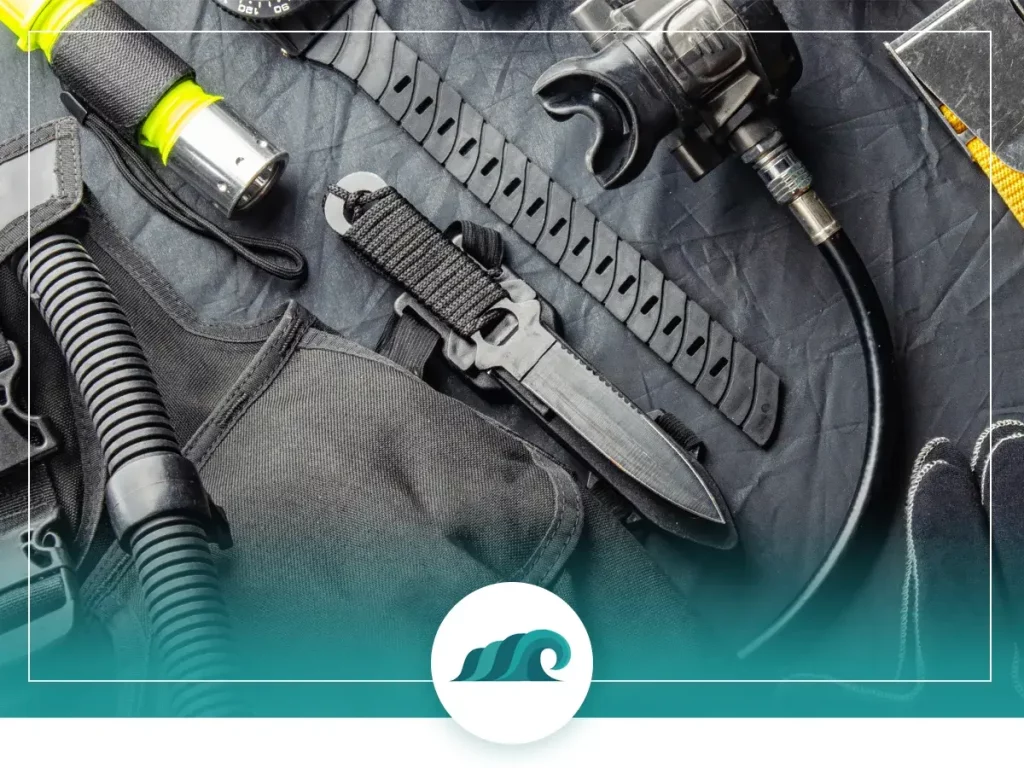
Picking the right dive knife will largely depend on your personal preferences and how you plan to use it. Dive knives are available in a variety of blade lengths, materials, tip shapes, and deployment methods.
Keep in mind that the best dive knife is the one you’ll carry with you – even a small knife is far better than none at all.
Blade Materials
There are two main blade materials used for dive knife blades: stainless steel and titanium. Either one is a good choice for a dive knife, but they have particular strengths and weaknesses.
Stainless Steel
Stainless steel is used in the majority of dive knives, and for good reason – it’s cheap, easy to sharpen, can hold an edge, and is corrosion-resistant.
It’s important to keep in mind that stainless steel is corrosion-resistant and not corrosion-proof. You’ll still need to properly dry your blade after use and remove rust should it start to develop.
Stainless steel is a softer metal than titanium, which means that it’s easier to sharpen – but doesn’t hold an edge quite as long. Because the metal is softer, you can actually achieve a sharper edge than with titanium.
Steel is heavier than titanium, which can be a consideration if you’re a freediver or spearo.
There a variety of alloys used in stainless steel blades – 420 and 420C being some of the more commonly found ones. These materials will hold up fairly well to saltwater use and can achieve a razor-sharp edge.
H1 steel is a newer alloy that utilizes 1% nitrogen instead of carbon – which makes it completely rustproof. However, it’s more expensive than typical stainless steel blades.
Titanium
Titanium is lightweight, durable and will hold an edge for a long period of time. The blades cost more than stainless steel but will maintain an edge for longer – which means less sharpening is needed.
Because they don’t contain any carbon, titanium blades are practically corrosion proof, so you don’t need to worry about rinsing and drying your blade after each use. If you’re hard on your gear like me – then titanium is the way to go.
Blunt Tip vs. Sharp Tip
There are a variety of blade shapes available, but the two most commonly found are sharp and blunt tips.
Blunt tips are great for recreational divers who want a tough blade that can also be used for prying, digging, and hacking. The squared-off tip means you don’t need to worry about breaking the tip by applying too much force. This type of tip also ensures you don’t accidentally puncture your BCD or poke a hole in your wetsuit.
Sharp tips are preferred by spearfisherman as well as divers in predator-filled waters. A sharp tip will enable you to quickly and humanely finish off your catch – and can be used as a self-defense tool to ward off hungry sharks that might want to snag your dinner!
There are also Tanto style tips which are sort of a hybrid of the two styles. These blades have a chisel point which makes them capable of prying as well as self-defense use.
Blade Length
Blade length will largely depend on your personal preference. Some people like a larger blade with a big handle, while others prefer the convenience of a compact blade.
Most dive knife blades fall somewhere between 2” and 6”. If you’re only going to get one knife I’d recommend going with a 3.5” – 5” blade, as it’s a good compromise between utility and size.
Keep in mind that unless you’re spearfishing, you probably won’t use your knife all that often. A small compact folding knife will perform nearly as well as a bulkier knife for most tasks you’re likely to encounter.
Fixed Blade vs. Folding Blade
As with regular knives, dive knives are available in both fixed blade and folding configurations.
Fixed blades are the most common type of dive knife on the market. They’re tough, solidly constructed, and can be used for a variety of tasks. Many feature full tang construction which means there is one solid piece of metal running from the blade tip to the pommel – which makes them useful for demanding tasks like prying and hammering.
Fixed blades are obviously bulkier than folding knives, and will take up more space when wearing them.
Folding blades are lightweight, compact, and can be stashed inside a BCD pocket. The downside is they can be difficult to deploy single-handed and if you’re wearing dive gloves can be downright impossible. They’re also not as tough as fixed blade knives – so aren’t suitable for hard use.
Straight Blade vs. Serrated
Both straight and serrated blades have their place in the underwater environment.
Straight blades are useful for cutting synthetic materials like monofilament line and nylon cordage, while serrated blades excel at cutting through netting, rope, and kelp. Straight blades are easier to sharpen yourself than serrated ones, but won’t keep their edge as long.
Luckily you don’t need to pick one blade style – as most modern knives feature both a straight and serrated section on the same blade.
Spearfishing Knife vs. Scuba Knife
Spearfishing kill knives are slimmer and lighter than most scuba knives. They’re typically stiletto shaped with a long pointy blade designed for maximum penetration. The blade shape makes them ideal for penetrating the brain stem and dispatching a trashing fish once you’ve speared it.
They also feature a slimmer profile – which makes them good for arm or ankle/leg mounting.
How and where to carry your dive knife
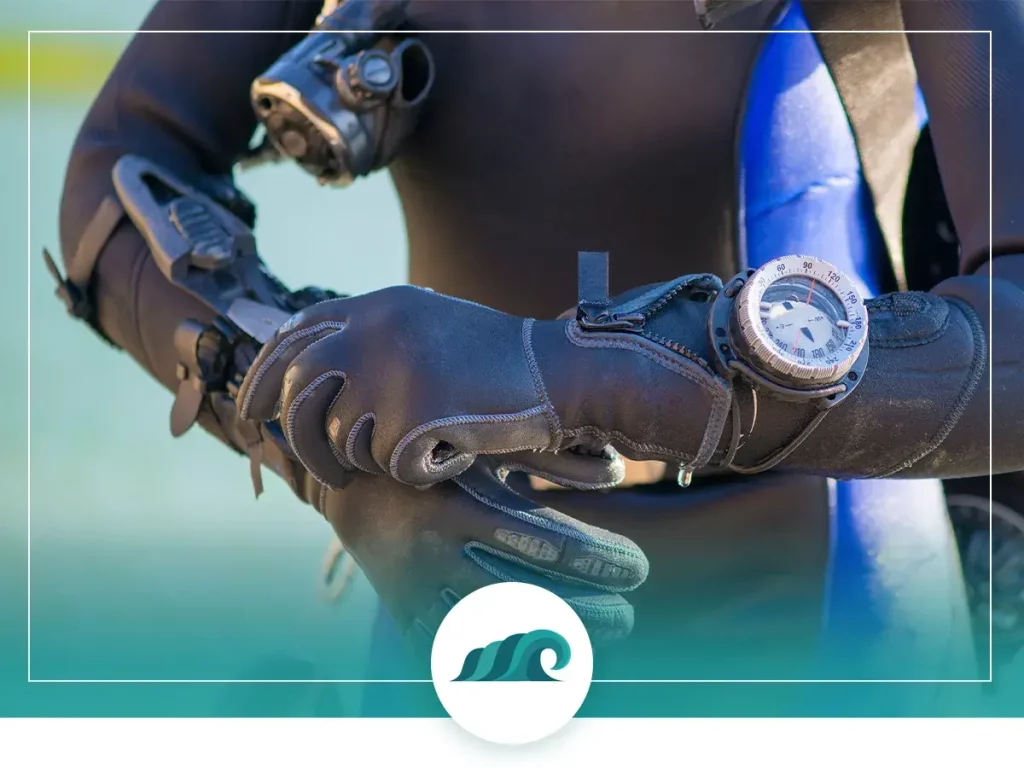
Ask 5 divers where the best place to mount a dive knife and you’ll get 10 opinions. It’s a hotly debated topic among both experienced divers and noobies.
Some of the most common places to strap a dive knife are the leg, waist, BCD, and forearm.
Leg/Ankle Carry
The classic James Bond in Thunderball look. If you want to look like an underwater badass then this is the only way to go!
This method works well for larger knives that would be cumbersome to mount on the waist or BCD. If you’re going to carry a larger knife on your ankle, make sure to mount it to the inside of your leg – that way it won’t get tangled up in line or vegetation. A slimmer profile dive knife can be mounted to the outside of your leg without the worry of entanglement.
One disadvantage of this mount is that it can be difficult to draw your knife if you got trapped in an enclosed space.
Waist Carry
An excellent choice for diving in kelp rich environments. Strapping your dive knife to your waist belt is the best way to ensure you avoid entanglements. It’s also a fairly easy place to draw your knife from.
BCD Carry
This is an increasingly popular way to store a dive knife. The knife can be stored inside a BCD pocket, clipped to the outside of the BCD with a lanyard or even rigged to the inflator hose.
Stashing your knife on your BCD means it’s easy to access, can be drawn with either hand, and the risk of entanglement is fairly low.
Forearm Carry
This is a great place to mount a smaller dive knife and is especially popular with spearos. It’s probably not the ideal spot for Scuba divers but can work well for a smaller backup knife.
A forearm mounted blade is easy to draw quickly, which is why it’s ideal for a spearfishing kill knife. Keep in mind that you’ll only be able to draw a forearm knife with your opposite hand – so if one arm became entangled you could be in trouble.
Dive Knife Maintenance
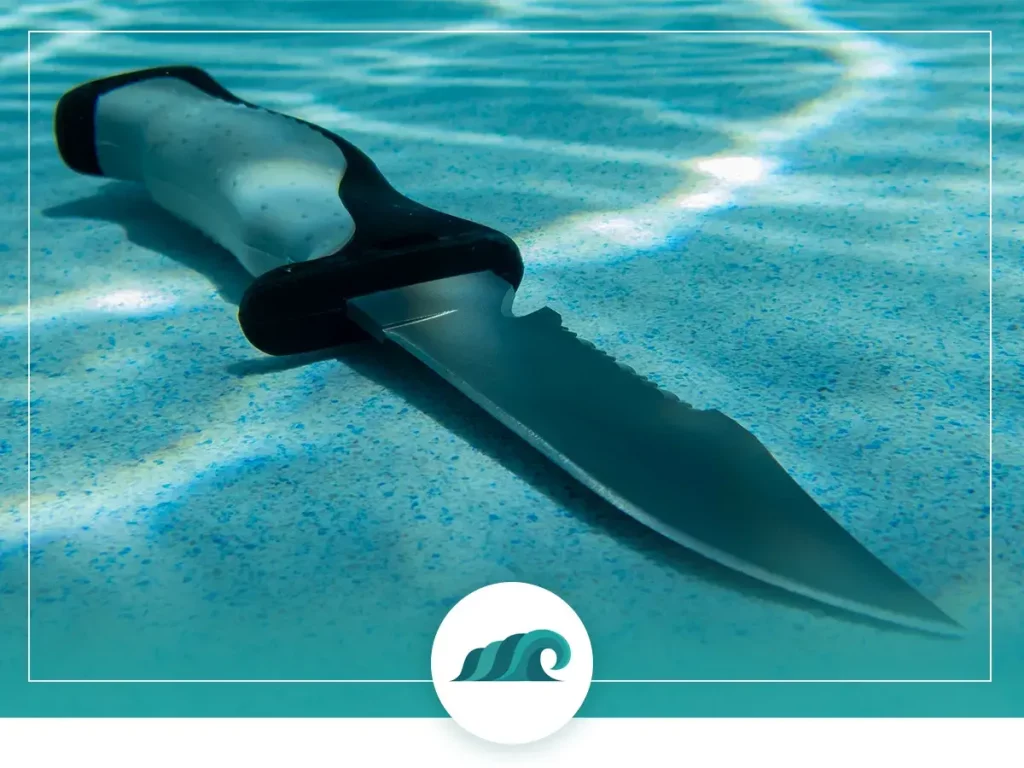
Maintaining your dive knife requires a bit more effort than a regular old knife. Assuming you’re using the blade in saltwater, you’ll need to keep an eye out for corrosion and clean it thoroughly after each use.
How to keep your dive knife in top shape:
- Rinse thoroughly with fresh water after every dive.
- Use a cloth to completely dry the blade.
- Coat the blade with a few drops of mineral oil.
- If rust or corrosion does start to develop, gently remove it by scrubbing with steel wool or Scotch-Brite.
- After removing the rust, coat the blade with a little mineral oil or petroleum jelly.
If your blade is made of stainless steel then you’ll need to be a bit more vigilant with maintenance than with a titanium blade.
Even the best blades get dulled over time – which means you’ll need to get your knife sharpened – or do it yourself. Dive shops can do this for you, or you can learn to sharpen your own knives with a whetstone. If you’ve got a titanium blade, keep in mind it will require a different technique to sharpen than stainless steel.
Other Considerations
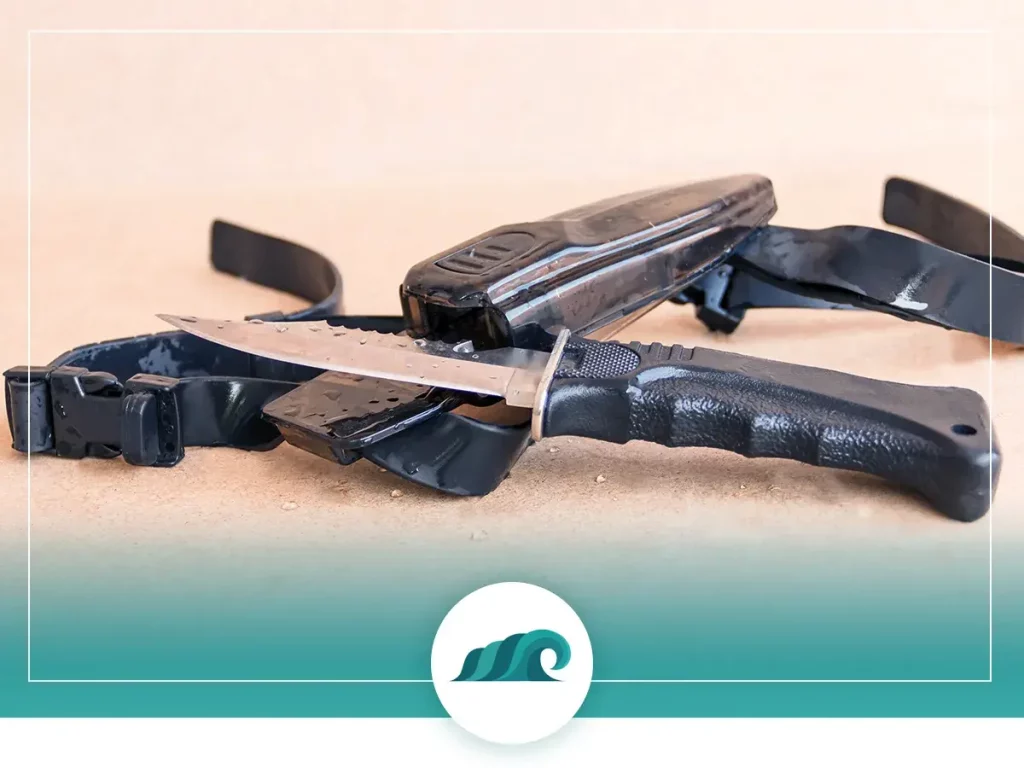
Sheath
In addition to the above factors, there are a few other considerations when choosing the best dive knife for you.
The sheath is often overlooked when picking out a dive knife – but it really shouldn’t be. It’s the attachment point between your knife and your body and will determine how easy it is to deploy your knife in an emergency situation.
Modern sheaths often feature a locking mechanism that allows one-handed deployment and replacement. Another feature to look out for is a magnetic sheath – which helps keep your knife from falling to the bottom of the sea!
Grip
Another overlooked aspect of dive knives is the grip. After all, gripping something underwater is much different than gripping it on dry land. Look for a textured handle that fits the shape of your hand.
If you normally wear dive gloves, then try out the grip with your gloves on to see if it works well. You don’t want to lose your knife to Davy Jones’ locker!
More Useful Features
Other features to look out for in a dive knife are a metal butt on the pommel and an integrated line cutter. Many full tang blades feature a metal butt on the bottom of the handle – which makes them useful for hammering or tapping to communicate. Line cutters are small notches built into the blade, which make cutting through monofilament fishing line a breeze.

